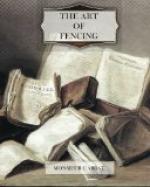Of the Opposition of the Hand.
Many People make no Distinction between the Parade and Opposition of the Hand, tho’ there is a very great Difference, the Parade being made only against the Adversary’s Thrust, and the Opposition to prevent a following Thrust after having parryed with the Sword, which is very necessary in most Thrusts, especially in the Risposts which may be made to your Thrust in Seconde.
Besides the Opposition of the Hand, after having parryed with the Sword, you may oppose with it, taking the Time, that is to say, when the Enemy pushes from above to below, as the motion of his sword is greater than your’s, having only a strait line to push Quarte on, whereas his from above to below, is crooked, so that pushing upon his time, he cannot avoid the thrust, and you may easily oppose his with the Left-hand, which is very different from the parade with the hand, to which you do not push ’till after you have parryed.
CHAP. XXIV.
Of the beat of the Foot, in closing the measure, or in the same place.
Though it may seem to many people, that the beat of the Foot, in gaining measure, making appels, or alurements, engagements, or other Thrusts, is rather ornamental than necessary; nevertheless, there is nothing puts the Foot in a better condition to follow the swiftness of the Wrist, in most of the actions of the Sword; nor can any thing contribute more to the equal situation, and to the retention of the Body, qualities, which keeping you covered from the time of your combatant, procures you the means, not only of taking advantage of his, but also of possessing firmness, freedom, justness and swiftness. You are to observe two sorts of beating, the one with the Foot firm in the same place, the other gaining measure; the Beat with the Foot firm, is done in two ways, the one in appels, or alurements on the Blade, and the other in engagements or Feints. That upon the allurement on the Blade, may be made by a single beat of the Foot, but those who are pretty well advanced, make two without lifting the Foot but once, the first with the Point, and the other with the whole Foot: that on engagements or single Feints, shou’d have but one beat, the thrust being to be made on the second motion. The beat of the Foot in marching or advancing, is also divided into two sorts, the one in Engagements or single Feints, and the other in Engagements and




